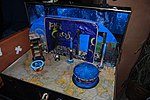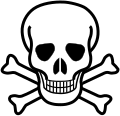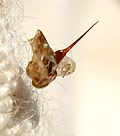 | Bees can suffer serious effects from toxic chemicals in their environments. These include various synthetic chemicals, particularly insecticides, as well... 35 KB (3,857 words) - 11:31, 12 April 2024 |
(13–16 °C). Bees and toxic chemicals Colony collapse disorder Endangered arthropod Fipronil Honey bee starvation Imidacloprid effects on bees Neonicotinoids... 37 KB (2,481 words) - 21:22, 5 January 2024 |
thuringiensis israelensis Bactericide Basta (herbicide) Bendiocarb Bees and toxic chemicals Benomyl Bensulide Benzimidazole fungicide Benzoylurea Benzyl benzoate... 8 KB (569 words) - 17:15, 2 January 2024 |
 | the larvae of many different species of moths. Moths, like butterflies, bees and other more popularly recognized pollinating insects, serve an essential... 30 KB (3,042 words) - 07:36, 24 April 2024 |
 | Mad honey (section Prevalence and harvesting) dysfunction and increase sexual performance. Most cases of mad honey poisoning are experienced by middle-aged men. Bees and toxic chemicals Mayor, Adrienne... 23 KB (2,539 words) - 15:34, 21 April 2024 |
 | Melipona (redirect from Melipone bee) 1988) Stingless bee List of stingless bees of Brazil Melittology Bees and toxic chemicals Trigona, another genus of stingless bees Wikimedia Commons... 8 KB (595 words) - 02:09, 11 May 2023 |
 | Clothianidin (category Articles containing unverified chemical infoboxes) (clothianidin, imidacloprid and thiamethoxam) for all outdoor uses. Bees and toxic chemicals Pesticide misuse Pesticide toxicity to bees Pollinator decline CID... 49 KB (5,314 words) - 10:46, 18 January 2024 |
 | fleas are attached (or appear to be attached) to miniature carts and other items, and encouraged to perform circus acts within a small housing. The first... 11 KB (1,120 words) - 14:49, 15 April 2024 |
Glossary of beekeeping (redirect from List of honey bee articles) and honey removal Beekeeping – bees are kept for their products (principally honey), and their utility in pollinating crops Bees and toxic chemicals Brood... 4 KB (491 words) - 14:19, 5 September 2023 |
 | Apitherapy (redirect from Bee Venom Therapy) of alternative medicine that uses honey bee products, including honey, pollen, propolis, royal jelly and bee venom. There has been no scientific or clinical... 11 KB (1,149 words) - 16:46, 7 February 2024 |
 | Imidacloprid (category Articles containing unverified chemical infoboxes) belonging to a class of chemicals called the neonicotinoids which act on the central nervous system of insects. The chemical works by interfering with... 48 KB (4,909 words) - 06:09, 14 April 2024 |
 | Deathwatch beetle (section Distribution and habitat) selection behaviour of deathwatch beetle, Xestobium rufovillosum". Journal of Chemical Ecology. 28 (4): 741–754. doi:10.1023/a:1015284625697. PMID 12035923. S2CID 29143888... 28 KB (3,571 words) - 08:30, 2 November 2023 |
 | Toxicity is the degree to which a chemical substance or a particular mixture of substances can damage an organism. Toxicity can refer to the effect on... 27 KB (3,097 words) - 18:23, 23 March 2024 |
Ecological Judaism Bali Communiqué Bali roadmap Basel Convention Bees and toxic chemicals Beetle bank Bering Sea Arbitration Bhopal disaster Bicycle-friendly... 40 KB (3,771 words) - 03:19, 4 March 2024 |
 | Fipronil (category Articles containing unverified chemical infoboxes) Fipronil is toxic to bees and should not be applied to vegetation when bees are foraging. Based on ecological effects, fipronil is highly toxic to upland... 32 KB (3,164 words) - 00:54, 13 April 2024 |
 | its abdomen and digestive tract, plus muscles and nerves. This massive abdominal rupture kills the honey bee. Honey bees are the only bees to die after... 14 KB (1,582 words) - 08:56, 29 April 2024 |
 | Acetamiprid (category Articles containing unverified chemical infoboxes) present in the honey bee after 72 hours. This might be a toxicological risk for honey bees, as chronic exposure can increase the toxicity of certain compounds... 16 KB (1,892 words) - 10:08, 29 April 2024 |
 | and viscous substance made by several species of bees, the best-known of which are honey bees. Honey is made and stored to nourish bee colonies. Bees... 115 KB (12,894 words) - 12:26, 23 April 2024 |
 | Bifenthrin (category Multiple chemicals in an infobox that need indexing) Bees In bees, the lethal concentration (LC50) of bifenthrin is about 17 mg/L. At sublethal concentrations, bifenthrin reduces the fecundity of bees,... 17 KB (1,839 words) - 10:38, 18 February 2024 |
 | Thiamethoxam (category Chemicals using indexlabels) birds, highly toxic to midges and acutely toxic for bees.: 20 The Globally Harmonized System of Classification and Labelling of Chemicals (GHS) classification... 21 KB (1,971 words) - 23:05, 3 April 2024 |
 | Schmidt sting pain index (category Insect bites and stings) less. Since many small bees are categorized into a pain level of 1, most toxic polypeptides in bee venom are melittin, apamin, and MCD peptide. Melittin... 14 KB (1,739 words) - 04:32, 26 April 2024 |
 | Bhopal disaster (redirect from Bhopal chemical disaster) dichloromethane and chloroform, in nursing women's breast milk. A 2004 BBC Radio 5 broadcast reported the site is contaminated with toxic chemicals including... 131 KB (14,367 words) - 21:16, 11 April 2024 |
 | Pollinator decline (category Bee ecology) cover and configuration, land management and pesticides, as these were considered very important drivers in most regions". Bees and toxic chemicals, Pesticide... 37 KB (4,197 words) - 16:14, 4 January 2024 |
 | Poison (redirect from Toxic Substances) Selective toxicity, controlled application, and controlled biodegradation are major challenges in herbicide and pesticide development and in chemical engineering... 34 KB (4,179 words) - 13:27, 10 April 2024 |
The 2019 Kim Kim River toxic pollution is a water pollution incident that occurred on 7 March 2019 caused by illegal chemical waste dumping at the Kim... 35 KB (3,165 words) - 11:58, 10 January 2024 |





